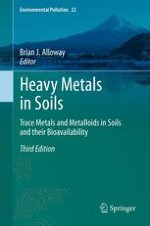2013 | OriginalPaper | Chapter
16. Selenium
Authors : Olav Albert Christophersen, Graham Lyons, Anna Haug, Eiliv Steinnes
Published in: Heavy Metals in Soils
Publisher: Springer Netherlands
Activate our intelligent search to find suitable subject content or patents.
Select sections of text to find matching patents with Artificial Intelligence. powered by
Select sections of text to find additional relevant content using AI-assisted search. powered by
